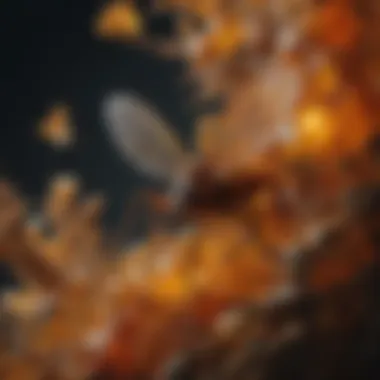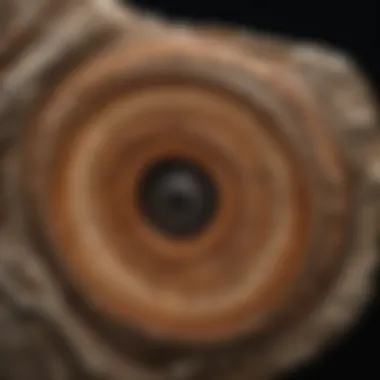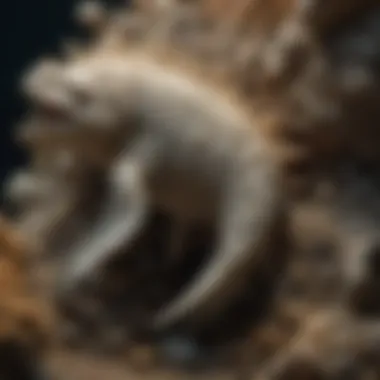Unveiling the Enigmatic Process of Fossilization: A Dive into Earth's Ancient Secrets


Rock and Fossil Identification
In the captivating realm of fossilization, understanding the types of rocks and fossils is crucial for enthusiasts and collectors. Different rocks, such as sedimentary, igneous, and metamorphic, house distinct fossils based on their formation. Identifying these fossils demands a keen eye for characteristics like texture, color, and composition. Tools like magnifying glasses, chisels, and brushes aid in the meticulous examination of fossils, revealing intricate details that unveil the ancient past.
Collecting Tips and Techniques
Delving into the world of rock and fossil collection requires adherence to best practices. Collectors should seek prime locations rich in fossil deposits, where a treasure trove of ancient relics awaits discovery. Safely extracting specimens involves delicate techniques to prevent damage, such as using soft brushes for cleaning and a steady hand during excavation.
Preservation and Display
Preserving rocks and fossils is an art form that ensures their longevity and pristine condition. Various techniques, including molding and casting, stabilize fragile specimens for future generations to admire. Proper storage methods involve archival materials that prevent decay and deterioration, safeguarding the valuable pieces of Earth's history. When it comes to display, creativity knows no bounds, with options such as shadow boxes, glass cases, or interactive exhibits captivating audiences and showcasing the beauty of fossils.
Geological Insights
Exploring the geological aspects of rocks and fossils provides valuable insights into Earth's evolution. Understanding geological formations and processes unveils the conditions under which fossils formed, shedding light on ancient ecosystems and climates. The historical significance of rocks and fossils is immense, with each discovery contributing to the puzzle of Earth's past. Notable findings in the field, from the Burgess Shale to the La Brea Tar Pits, offer windows into prehistoric worlds, enriching our understanding of the planet's history and the creatures that once roamed its landscapes.
Introduction to Fossilization
Fossilization is a captivating process that unveils the transformation of organisms into ancient relics over millions of years. In this article, we will delve deep into the intricate journey of fossilization, shedding light on how decay morphs into meticulous preservation, offering a unique glimpse into Earth's rich history and the mysteries it holds.
Understanding the Concept of Fossilization
The Definition of Fossilization
Fossilization encapsulates the process by which the remains of living organisms transform into fossils through geological processes. This fundamental aspect plays a pivotal role in understanding ancient life forms and Earth's history. The key characteristic of fossilization lies in preserving the physical structures of organisms, enabling scientists to study long-extinct species. Its unique feature is the ability to capture intricate details of ancient life forms. Despite its significance, challenges such as incomplete fossilization can hinder the accuracy and completeness of scientific findings.
The Significance of Fossils in Science
Fossils serve as invaluable records of past life on Earth, providing crucial insights into evolution, ecology, and geological history. They act as tangible evidence of ancient organisms, aiding researchers in reconstructing the planet's biological timeline. The key characteristic of fossils in science is their capacity to bridge the gap between past and present, allowing scientists to unravel evolutionary patterns. Their unique feature lies in serving as indicators of environmental changes and biodiversity shifts throughout history. While fossils offer a treasure trove of information, interpretation challenges and specimen deterioration can present obstacles in scientific analysis.
Types of Fossilization Processes
Permineralization
Permineralization involves the gradual infiltration of minerals into porous organic tissues, leading to the preservation of cellular structures. This process is vital in maintaining the integrity of fragile remains, ensuring their longevity in the fossil record. The key characteristic of permineralization is the formation of mineral replicas of the original tissue, allowing for detailed microscopic examination. Its unique feature lies in capturing fine anatomical features not typically observed in other fossilization methods. Despite its benefits, over-mineralization can distort morphological details, posing challenges to accurate interpretation.
Replacement
Replacement occurs when original organic material is replaced by minerals, resulting in the preservation of the organism's external shape. This process is essential in cases where delicate structures need to be reinforced for long-term conservation. The key characteristic of replacement lies in maintaining the organism's form while enhancing its durability through mineral replacement. Its unique feature is the creation of sturdy fossil replicas that withstand geological pressures and weathering effects. However, inaccuracies in mineral substitutions can lead to misrepresentations of the original organism's features, influencing scientific interpretations.
Carbonization


Carbonization involves the preservation of organisms through the residual carbon impressions left behind after decay. This process is particularly common in prehistoric plant specimens, where high carbon content facilitates fossilization. The key characteristic of carbonization is the production of detailed carbon imprints that offer insights into ancient flora morphology. Its unique feature lies in capturing delicate plant structures with exceptional clarity, aiding in taxonomic classification. Despite its advantages in visual clarity, carbonization can result in flattened representations, limiting the three-dimensional information available for study.
Recrystallization
Recrystallization occurs when minerals within an organism's remains undergo rearrangement, leading to the formation of new crystalline structures. This process plays a crucial role in stabilizing fragile fossils and enhancing their overall durability. The key characteristic of recrystallization is the restoration of structural integrity in fossilized specimens, prolonging their preservation in sedimentary layers. Its unique feature lies in the transformation of amorphous minerals into organized crystalline patterns, showcasing the potential for microstructural analysis. Despite its benefits, recrystallization can obscure original textures and features, complicating the identification of specific biological components.
Authigenic Mineralization
Authigenic mineralization involves the precipitation of minerals directly onto organic tissues, creating a protective mineral coating that encapsulates the organism. This process contributes to the long-term conservation of soft-bodied organisms that lack hard parts. The key characteristic of authigenic mineralization is the formation of mineral encasements around delicate structures, safeguarding them from external damage. Its unique feature lies in the enhancement of fossil stability through mineral encrustation, enabling the preservation of intricate soft tissues that are often susceptible to decomposition. However, the overgrowth of minerals can obscure fine anatomical details, posing challenges in the accurate reconstruction of fossilized organisms.
Factors Influencing Fossilization
Environmental Conditions
Environmental conditions play a critical role in determining the success of fossilization processes by facilitating or hindering the preservation of organic remains. Factors such as temperature, moisture levels, and sediment composition directly impact the decay and fossilization rates of organisms. The key characteristic of environmental conditions is their influence on the overall decomposition process, affecting the timeline and quality of fossil formation. Their unique feature lies in shaping the chemical reactions and microbial activities that guide fossilization, ultimately determining the integrity of fossil records. Despite their importance, fluctuations in environmental parameters can disrupt fossilization processes, leading to variations in preservation quality and fossil abundance.
Quick Burial
Quick burial is a key factor in promoting successful fossilization by preventing scavenging, erosion, and microbial degradation of organic remains. Rapid burial helps shield organisms from external disturbances, creating an environment conducive to fossil formation. The key characteristic of quick burial is its ability to isolate organic materials from destructive agents, preserving them in a relatively undisturbed state. Its unique feature lies in maintaining the spatial integrity of fossil assemblages, allowing for the accurate reconstruction of ancient ecosystems. While quick burial enhances the preservation potential of fossils, rapid sedimentation rates and burial upheavals can also lead to the fragmentation or displacement of specimens, impacting the interpretative value of fossil deposits.
Presence of Hard Parts
The presence of hard parts in organisms significantly influences their fossilization potential, as durable structures have higher chances of long-term preservation compared to soft tissues. Skeletal elements, shells, and exoskeletons provide structural support that resists decay and mechanical degradation, increasing the likelihood of fossil formation. The key characteristic of hard parts is their capacity to withstand environmental pressures and biological processes, ensuring the longevity of fossilized remains. Their unique feature lies in offering detailed anatomical information and taxonomic clues that aid in species identification and evolutionary studies. While hard parts contribute to robust fossil records, their biased representation in the fossil record can skew scientific interpretations towards organisms with mineralized components, neglecting the diversity of soft-bodied taxa and incomplete ecological reconstructions.
Stages of Fossilization
In the realm of paleontology, the stages of fossilization stand as a crucial focal point in understanding the intricate process through which organisms transform into ancient relics over vast expanses of time. These stages encapsulate the very essence of how remnants of past life can be preserved and studied, offering invaluable insights into Earth's biological and geological history. As we traverse the journey of fossilization, we embark on a compelling exploration into the depths of time, unraveling the mysteries that lie hidden within the petrified remains of once-living beings.
Decay and Burial
Delving into the initial phases of fossilization unveils the pivotal roles played by decay and burial in preserving organisms for posterity. The processes of decay and burial set the foundation for the subsequent stages of mineralization and petrification, laying the groundwork for the transformation of organic matter into enduring fossils. From the microbial breakdown of tissues to the gradual entombment in sediments, decay and burial serve as the essential prelude to the fossilization saga.
Initial Decomposition
Within the realm of initial decomposition, the organic matter of deceased organisms undergoes a gradual breakdown orchestrated by a myriad of microbial agents. The intricate interplay between bacteria, fungi, and other decomposers initiates the process of decay, breaking down complex biological structures into simpler components. This decomposition phase not only recycles nutrients back into the ecosystem but also creates the requisite conditions for subsequent mineralization and fossilization processes. Despite its seemingly disruptive nature, initial decomposition represents a vital juncture in the journey towards fossilization, signifying the transition from organic to inorganic preservation.
- The key characteristic of initial decomposition lies in its ability to enzymatically break down complex organic molecules, paving the way for further preservation processes.
- This phase serves as a beneficial choice for this article by elucidating the foundational role of decay in the overall fossilization narrative.
- The unique feature of initial decomposition lies in its dual role of facilitating nutrient recycling and organic to inorganic transition, highlighting its significance in evolutionary and paleontological studies.
Covering and Protection
As organisms succumb to the forces of decay, the subsequent covering and protection phase emerges as a critical shield against complete disintegration. Burial under layers of sediment shields organic remains from scavengers and environmental disturbances, creating a haven where intricate details can be meticulously preserved. The process of covering and protection not only shields the remains from external harms but also provides the isolation necessary for mineral infiltration and solidification, fostering the gradual metamorphosis of soft tissues into durable fossils.


- The key characteristic of covering and protection is its role in shielding organic remains from external factors that could accelerate decomposition, ensuring the longevity of fossilization processes.
- This phase is a popular choice for this article due to its pivotal function in preserving delicate structures and enabling the mineralization of biological tissues.
- The unique feature of covering and protection lies in its dual role of safeguarding remains from decay while facilitating the transformation of organic matter into enduring fossils, underscoring its indispensable role in the fossilization continuum.
Exceptional Fossilization Cases
Exceptional fossilization cases play a pivotal role in shedding light on the remarkable world of fossilization. These cases represent unique instances where soft tissues or delicate features of organisms are exceptionally preserved, providing invaluable insights into ancient life forms. By examining exceptional fossilization cases, scientists can unravel details that would typically not withstand the test of time and decomposition. This section will delve into the significance and implications of these extraordinary findings, illustrating their impact on our understanding of prehistoric creatures and ecosystems.
Soft Tissue Preservation
Impressions and Molds
Impressions and molds serve as a fascinating aspect of soft tissue preservation within the realm of exceptional fossilization cases. These features capture the intricate details of organisms, offering a glimpse into their physical characteristics and behaviors. Impressions and molds are crucial for paleontologists in reconstructing the appearance and movements of ancient creatures with remarkable accuracy. The distinctiveness of impressions and molds lies in their ability to provide a three-dimensional snapshot of organisms, enabling researchers to study their anatomy and adaptations comprehensively. While these preservation methods offer rich data for scientific analysis, they may be susceptible to deformation over time, impacting the accuracy of reconstructions.
Freezing and Mummification
Freezing and mummification represent another intriguing aspect of soft tissue preservation observed in exceptional fossilization cases. These processes involve the rapid preservation of organisms in conditions such as ice or desiccation, preventing decay and maintaining tissue integrity. Freezing and mummification are highly advantageous for preserving soft tissues in their original state, offering researchers a rare opportunity to examine ancient specimens with minimal alteration. The unique feature of these methods lies in their ability to retain delicate structures and features that would typically degrade rapidly under normal fossilization conditions. However, challenges may arise in the interpretation of data due to potential alterations caused by freeze-thaw cycles or desiccation effects, emphasizing the need for meticulous analysis and documentation.
Extraordinary Fossil Finds
Amber Encasements
Amber encasements stand out as a remarkable feature in extraordinary fossil finds, showcasing the exceptional preservation of organisms within fossilized tree resin. These encasements provide a protective environment that seals organisms in a pristine state, safeguarding soft tissues from decay and external influences. The key characteristic of amber encasements lies in their ability to capture organisms with astonishing detail, preserving intricate structures such as feathers or delicate appendages. This method offers a high level of fidelity in preserving ancient specimens, allowing researchers to study them with unprecedented clarity. However, the limitation of amber encasements pertains to the restricted range of organisms preserved in this manner, leading to biases in the types of fossils recovered.
Tar Pit Discoveries
Tar pit discoveries present a unique perspective on extraordinary fossil finds, showcasing preserved remains in natural asphalt deposits. These discoveries highlight instances where organisms become trapped in viscous tar, leading to their exceptional conservation over time. The key characteristic of tar pit discoveries lies in their ability to capture a snapshot of ancient life, preserving not only skeletonized remains but also soft tissues and environmental clues. This method offers a rare opportunity to study complete ecosystems from the past, providing insights into the interactions between species and their habitats. Challenges may arise in extracting specimens from tar pits due to the sticky nature of the material, requiring careful excavation procedures to ensure the integrity of the fossils.
This detailed exploration of exceptional fossilization cases and their subcategories underscores the importance of these findings in expanding our knowledge of ancient life forms and ecosystems. By unraveling the intricacies of soft tissue preservation, researchers can glean valuable information that enhances our understanding of prehistoric biodiversity and evolutionary dynamics.
Significance of Fossilization
Fossilization holds a paramount significance in the realm of Earth's history and scientific inquiry. This article aims to shed light on the critical role that fossilization plays in unraveling the mysteries of our past. By examining the preserved remains of ancient organisms, scientists can trace the evolution of life on our planet and decipher crucial insights into biodiversity, extinction events, and ecological shifts. Furthermore, fossils serve as tangible evidence of geological processes, offering a window into the deep time scales of our planet's formation and transformation. Understanding the significance of fossilization not only enriches our knowledge of the past but also informs present-day research in fields such as paleontology, evolutionary biology, and climate science.
Scientific Insights from Fossils
Evolutionary Studies
Evolutionary studies conducted through fossil analysis provide a unique perspective on the processes that have shaped life on Earth over billions of years. By examining fossilized remains, researchers can reconstruct evolutionary lineages, identify transitional forms, and study the patterns of adaptation and speciation that have driven biological diversity. Evolutionary studies offer a valuable tool for understanding the mechanisms of evolution, including natural selection, genetic drift, and environmental pressures. Despite the inherent limitations of the fossil record, evolutionary studies play a fundamental role in piecing together the tree of life and tracing the origins of modern organisms in this article.
Climate Change Indicators
Fossils also serve as essential markers for studying past climates and environmental change. Certain fossil species are sensitive to specific ecological conditions, allowing scientists to infer temperatures, precipitation levels, and atmospheric compositions from ancient ecosystems. Climate change indicators derived from fossil evidence provide valuable insights into the Earth's history of environmental transformations, illustrating past instances of global warming, ice ages, and other climatic shifts. By analyzing fossil assemblages and isotopic signatures, researchers can reconstruct past climates with remarkable precision and draw parallels to contemporary climate change patterns. The integration of climate change indicators into fossilization studies enhances our understanding of Earth's dynamic environmental systems and the interconnectedness of life forms throughout geological time scales in this article.


Challenges in Fossilization Studies
In the realm of paleontology, delving into the challenges surrounding fossilization studies is paramount to understanding the complexities and uncertainties that researchers face. This section aims to shed light on the pivotal role that challenges play in shaping our knowledge of ancient life forms and ecosystems. By unraveling the enigmas and limitations presented by missing links and incomplete fossils, scientists can strive towards a more comprehensive picture of Earth's history.
Missing Links and Incomplete Fossils
Transitional Forms
Transitional forms hold a crucial position in the narrative of evolution and fossilization studies. These elusive specimens bridge the gaps between distinct species, offering a glimpse into evolutionary processes that have shaped life on our planet. The significance of transitional forms lies in their ability to provide tangible evidence of gradual transformations, showcasing intermediary stages in biological development. Key characteristics of transitional forms include exhibiting traits from both ancestral and descendant species, offering a mosaic of features that highlight evolutionary transitions. Despite the inherent challenges in identifying transitional forms due to their subtle and nuanced nature, their presence serves as a linchpin for understanding the interconnectedness of life forms and the mechanisms driving evolutionary change.
Fragmentary Specimens
Fragmentary specimens, although incomplete, play a crucial role in the tapestry of fossil records. These partial remnants offer snapshots of ancient life, allowing scientists to piece together fragments of the past and infer broader patterns of biological diversity and adaptation. The key characteristic of fragmentary specimens lies in their ability to provide glimpses into otherwise lost worlds, offering clues about long-extinct organisms and their habitats. While fragmentary specimens may pose challenges in reconstructing entire organisms or ecosystems, their contributions to paleontological studies should not be underestimated. By carefully analyzing and interpreting these incomplete remains, researchers can fill in gaps and acquire valuable insights into evolutionary trajectories and ecological relationships.
Contamination and Preservation Issues
Contamination of fossil samples and preservation challenges are two critical aspects that researchers confront during fossilization studies. Each presents unique hurdles that must be navigated to ensure the integrity and accuracy of scientific findings.
Modern Contaminants
The infiltration of modern contaminants into fossil samples can compromise the authenticity and reliability of data interpretations. Identifying and mitigating the impact of modern contaminants is essential to avoid erroneous conclusions and ensure the purity of fossil specimens. Modern contaminants can introduce foreign elements that distort original compositions, leading to inaccuracies in carbon dating, isotopic analysis, and overall fossil characterization. Therefore, rigorous protocols for sample collection and preservation are imperative to safeguard against contaminant interference and uphold the credibility of research outcomes.
Decay and Deterioration
The inexorable processes of decay and deterioration pose significant challenges to the preservation of fossilized remains over geological timescales. Fossils are susceptible to degradation from environmental factors, chemical reactions, and physical disturbances, necessitating meticulous conservation strategies to prolong their lifespan and retain vital information for scientific exploration. Decay and deterioration can erode delicate structures, obscure intricate details, and diminish the overall integrity of specimens, hindering comprehensive analyses and interpretations. By understanding the mechanisms of decay and deterioration, researchers can develop innovative preservation techniques and protective measures to safeguard precious fossil relics for future generations.
Future Prospects in Fossilization Research
In this article, we delve into the promising realm of Future Prospects in Fossilization Research, shedding light on the innovative paths that paleontology is taking to unravel the mysteries of ancient life forms. The evolution of technology plays a pivotal role in enhancing our understanding of fossils and their significance in reconstructing Earth's history. By exploring the advancements in research methodologies and tools, we pave the way for groundbreaking discoveries that shape our knowledge of prehistoric ecosystems and their inhabitants.
Technological Advancements in Paleontology
3D Scanning and Reconstruction
3D Scanning and Reconstruction revolutionize the field of paleontology by creating highly detailed virtual models of fossil specimens. This technological marvel captures every minute feature with precision, allowing scientists to examine fossils in intricate detail without risking damage to the original artifact. The ability to create digital replicas of fossils enables researchers to analyze specimens from multiple angles, aiding in accurate classification, preservation, and dissemination of findings. While 3D Scanning and Reconstruction streamline the study of fossils, their utilization in this article adds a layer of depth and authenticity to our exploration of fossilization processes.
Isotopic Analysis
Isotopic Analysis serves as a cornerstone in deciphering the chemical composition and geological history of fossils. By studying the stable isotopes present in fossilized remains, researchers can unravel ancient environmental conditions, dietary habits of extinct species, and even migration patterns of prehistoric creatures. This method provides invaluable insights into the interconnectedness of organisms within past ecosystems, shedding light on evolutionary adaptations and ecological dynamics. Incorporating Isotopic Analysis into our discourse on fossilization enriches the narrative by highlighting the extensive data insights obtained through this technique.
Digital Archiving and Data Sharing
In the digital age, the preservation and sharing of paleontological data play a crucial role in advancing research and fostering collaboration among experts worldwide. Digital Archiving and Data Sharing empower scientists to document, store, and disseminate vast collections of fossil records efficiently. Virtual Repositories serve as digital libraries that house a wealth of information, including images, descriptions, and research findings, accessible to researchers, educators, and enthusiasts globally. By embracing Virtual Repositories, this article underscores the importance of preserving fossil data for future generations and promoting open access to accelerate scientific discoveries.
Collaborative Platforms
Collaborative Platforms facilitate discourse and knowledge exchange within the paleontological community, enabling researchers to collaborate on projects, share insights, and pool resources for collective progress. These platforms create a virtual space where experts from diverse fields can engage in discussions, co-author publications, and address research challenges collaboratively. Through Collaborative Platforms, the synergy of intellect and expertise propels scientific endeavors forward, nurturing a culture of inclusivity and interdisciplinary exploration. By spotlighting Collaborative Platforms, we emphasize the collaborative nature of scientific inquiry and its transformative impact on fossilization research in the digital era.







